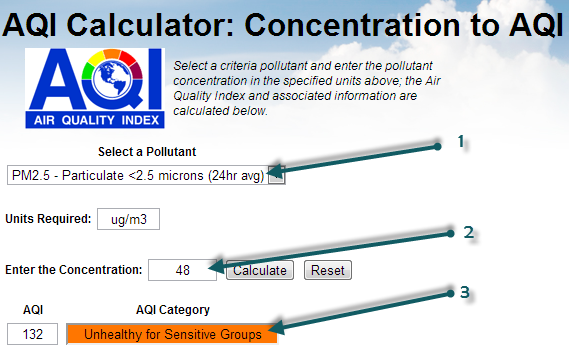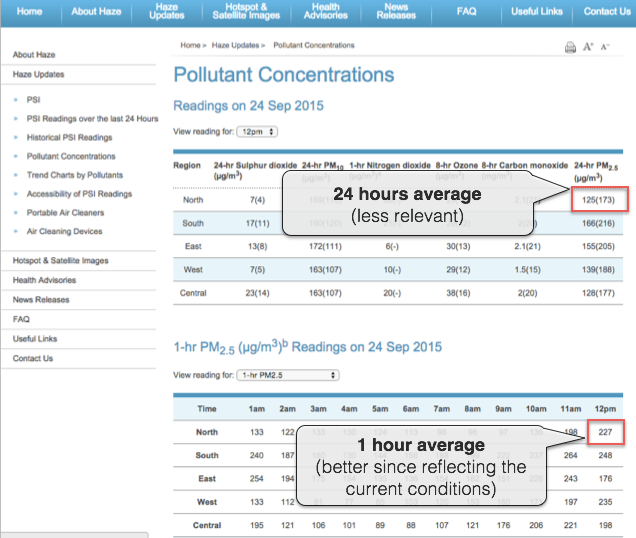In April 2014, the Singapore NEA has updated the PSI calculation to also include PM2.5. http://www.nea.gov.sg/anti-pollution-radiation-protection/air-pollution-control/psi
Με το πρόσφατο νέφος της Νοτιοανατολικής Ασίας από την Ινδονησία να επηρεάζει τη Σιγκαπούρη και τώρα τη Μαλαισία , έχουμε πολλές ερωτήσεις σχετικά με το γιατί υπάρχει διαφορά μεταξύ των δεδομένων που μπορούν να διαβαστούν από τον ιστότοπο Singapore NEA ( nea.gov.sg ) και το έργο World Air Quality Index Singapore ιστοσελίδα .
Για παράδειγμα, δείτε τι μπορείτε να διαβάσετε σήμερα στην ιστοσελίδα των ΝΕΑ:

Για κάποιο ιστορικό λόγο, η Σιγκαπούρη χρησιμοποιεί το PSI ( Ρυπογόνος Δείκτης ) για να αξιολογήσει την ποιότητα του αέρα. Στην παραπάνω εικόνα, ο αριθμός 1 αντιστοιχεί στην τιμή PM10 που χρησιμοποιείται για την αξιολόγηση PSI. Η τιμή 67(/59) μπορεί να διαβαστεί ως 67 μg/m3, που αντιστοιχεί σε PSI 59. Το PSI αξιολογείται ως το μέγιστο του μεμονωμένου PSI για κάθε έναν από τους ρύπους: PM 10 , SO 2 , NO 2 , O 3 (Όζον) και CO 2 .
PSI(Singapore-North) = max( PSIPM10-based, ... PSIO3-based )= max (59, ..., 77) = 77
Τούτου λεχθέντος, το ενδιαφέρον είναι ότι, στον ίδιο πίνακα, τα δεδομένα PM2.5 παρέχονται επίσης στην τελευταία στήλη (βλ. 3). Αυτά τα δεδομένα παρέχονται μόνο σε μg/m3 (βλ. 2), και δεν υπάρχει μετατροπή σε κάτι σαν το PSI (δηλαδή μετατροπή από τη μάζα PM2,5 σε δείκτη ρύπανσης ή ποιότητας). Ωστόσο, αυτή η μετατροπή υπάρχει και ορίζεται από την Υπηρεσία Προστασίας του Περιβάλλοντος των ΗΠΑ . Ο ευκολότερος τρόπος για να κάνετε τη μετατροπή είναι να χρησιμοποιήσετε την ηλεκτρονική αριθμομηχανή, που είναι διαθέσιμη στο airnow.gov :

If you select the PM2.5 (1), then enter the mass concentration of 48 (2), can click on Calculate, you will obtain the AQI of 132 (3). So, based on the PM2.5 AQI conversion, the PSI that is used for Singapore could be extended (let's call it PSI++) to also take into account the PM2.5 information. In which case, the PSI++ would be the maximum of the regular PSI (based on PM10 only) and the PM2.5 AQI:
PSI++ = max( PSI, AQIPM.25 ) = max( 77, 132 ) = 132
This PSI++, that is commonly referred as AQI (or Air Quality Index), is what is being used on the the World Air Quality Index project, for all the cities (provided PM2.5 is available for the city). And this explains why the values are different between the NEA website and the World Air Quality Index project.
Moreover, when doing the convertion, make sure you use the 1-hour reading for the PM2.5 concentration rather than the 24-hours averaged value, as shown on the below image:

http://www.haze.gov.sg/haze-updates/pollutant-concentrations/type/PM25-1Hr
If you want to know more about PM10 vs PM2.5, and especially why PM10 is still used, please check the faq entry about why is PM2.5 often higher than PM10? Is PM10 still a relevant measure?
--
For more information about specific countries or continent, please refer to those articles: Thailand and Malysia - India - China - Hong Kong / Canada (Air Quality Health Index) - South America - Australia - Quebec and Montreal - Singapore - Poland - Indonesia .
For information about the 24 hours averaging used or Ozone and Particulate Matter (PM2.5), please refer to those two articles: Ground Ozone Index - PM2.5 Instant Cast
